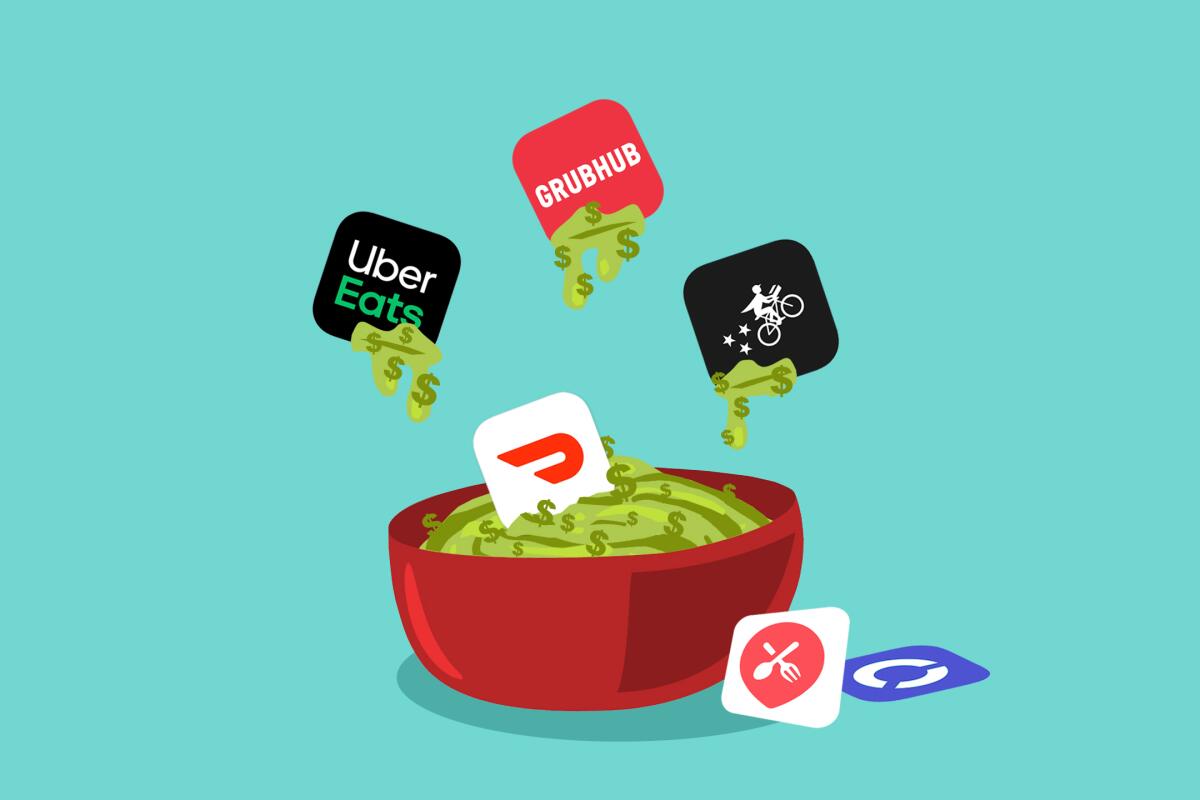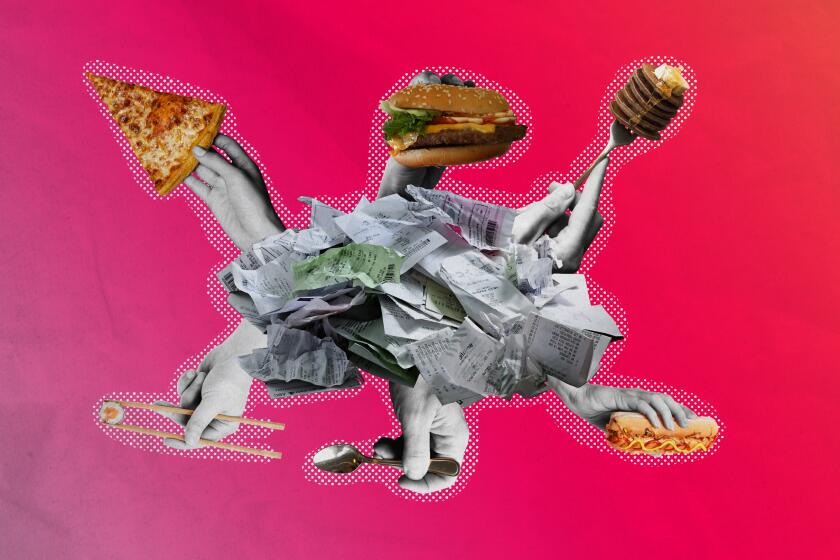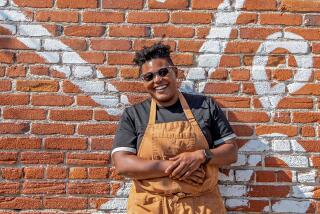The next time you order takeout, call the restaurant

- Share via
What can you buy with $35,000? A house in some parts of the country. Or a new Mustang with a high-performance package.
For Caitlin and Daniel Cutler, that’s one-third of a year’s rent at Ronan, their Melrose Avenue Italian restaurant. It’s also what they spent on food delivery service fees in 2020.
The couple have always budgeted for rent, but they could not have anticipated the devastating effects of a pandemic: a precipitous drop in sales and the skyrocketing expenses associated with getting their food to takeout customers. (In December, delivery apps accounted for 74% of Ronan’s business.)
So the Cutlers did what some in need of a good vent did: They posted their frustrations on Instagram.
“We just got our year-end financials back. … Not only did we lose money (a given, pandemic and all), but to add insult to injury, we spent $35,000 on delivery service fees this year,” Caitlin wrote on Jan. 12.
For many restaurants, these food delivery companies provide a service they cannot offer on their own. But the tally of the charges has been a shock to many, including Caitlin.
The Cutlers pay an 18% fee per order to Caviar, 20% to Postmates, 18% to Doordash, 20% to Uber Eats, and 3% to Tock; they also pay $119 per month for a one-year contract with ChowNow.
“Every time I post about how much the apps charge, someone tells me, ‘I didn’t know that,’” Caitlin said. “When we got the year-end number, I thought, ‘This is a tangible number that people can understand versus me just saying this is hard.’ ”
Her post elicited more than 100 comments, most from people who vowed to stop using the apps and instead order directly from the restaurant.
Food delivery services have invaded nearly every aspect of our lives, from the commercials between streaming videos to ads on social media and countless coupon codes. Revenues for the food delivery market in the U.S. are expected to grow from $26 billion in 2020 to $42 billion in the next five years, according to Business of Apps, a company that offers analysis, data and a marketplace for app businesses.
It’s hard to envision a world without the ease of clicking on “deliver.”
But, as my colleagues and I have reminded you, when you order directly from restaurants, they can avoid paying commissions to third-party services. At a time when independently owned restaurants are fighting to keep their doors open, getting hit with a 20% to 30% commission fee on every order just isn’t sustainable.
Spoon by H restaurant is closing after months of reduced business, chargebacks and refund requests during the pandemic. It’s just one of many restaurants footing the bill as diners discover new ways to dine and dash.
In the city of Los Angeles and in unincorporated areas of Los Angeles County, it is unlawful for third-party food delivery services to charge a restaurant more than a 15% commission fee for an online order during the local public health emergency related to COVID-19. It also is unlawful to charge more than 5% for marketing (or other nondelivery fees).
Tony Arranaga, communications director for L.A. City Councilman Mitch O’Farrell, who introduced the city ordinance last year, specified the cap further.
“The additional 5% can only be charged for non-menu item-related services such as promotions,” Arranaga wrote in an email. “The restaurant has to agree with the delivery app company on that type of arrangement. In other words, that extra 5% cannot be used by the app company as the price of doing business for the delivery app’s services.”
Both the L.A. city and county ordinances remain in place until 90 days after indoor dining can resume at full capacity, but some restaurateurs say the 20% is still too much and that if you’re in a city without its own fee cap, services can charge more.
In January, Assemblywoman Lorena Gonzalez (D-San Diego) introduced AB 286, which would create a statewide fee cap of 15% of the menu-listed price of an online order.
Jack Li, owner of Hui Tou Xiang restaurant in San Gabriel — which does not have a fee-capping ordinance — was used to long waitlists and a packed dining room prepandemic, with diners crowding in for blintz-shaped pork dumplings and house-made kimchi.
With no foot traffic now, Li says more than half of his business is coming through the delivery apps. Forgoing that exposure is simply not an option.
Last year, he paid $21,000 to Grubhub and about $14,000 to Postmates. At one point, he says he was paying around 25% in fees to both services. Uber Eats and Door Dash wanted to charge 30% to 35% before the pandemic, so he never signed up.
Attempting to navigate the crosscurrents of delivery app speak, guidelines and charges can be a maddening task.
“Their statements are really hard to read,” Li said. “Calling them is just a pain, because anything outside of order problems, they transfer you to an account specialist and it takes forever.”
Sandra Cordero, chef-owner of Gasolina Cafe, a Spanish restaurant in Woodland Hills, says she noticed a change in fees in June. She said she paid Grubhub 16% in October, 17% in November and 13% in December.
A new proposed Los Angeles city ordinance could set a 15% food delivery service fee cap.
“It’s just hard to see,” she said. “They change it on you. [You don’t catch it], especially if you’re doing three or four different services.”
She also noticed a change in her Postmates rates in June. At one point, she was paying 29% per order. In June, it was 20%, and it dropped to 19% and 18% in July and August, respectively.
“I remember we called, but you get put on hold, and you get sent from one person to another, and it just takes so much time,” she said.
Li is similarly frustrated. After reviewing his 2020 Grubhub statements, he noticed that fees labeled “online delivery orders,” “online pickup orders” and “delivery commission” had in May been changed to “service rates,” “marketing services,” “standard orders” and “deliveries.” Li said that he never asked for any marketing services and that he hadn’t noticed a change in his services either. I sent Li’s statements to Grubhub, asking for an explanation.
“The services didn’t change, just the way things were categorized,” a representative for the company wrote in an email. He also included a link to an online explanation that was sent to restaurants.
Li paid fees ranging from 21.31% to 23.63% from September to December.
If restaurateurs believe a food delivery company is violating the county cap, they can contact the Department of Consumer & Business Affairs. A media specialist for L.A. County says the department has not received any complaints.
If a company is violating the city of Los Angeles’ cap, businesses can contact the L.A. City attorney’s office. Not a single restaurant has sent a complaint, says Rob Wilcox, director of community engagement and outreach for city attorney Mike Feuer.
“The food delivery app fee cap was enacted to help them maintain their businesses and continue to serve their communities during this crisis,” says Feuer. “I encourage anyone who knows of a delivery app that is not complying with the law to send the complaint to my office and we will take appropriate action.”
However, for some restaurant owners, taking the time to recheck their statements is time they don’t have. Barbara Sky Burrell, owner of Sky’s Gourmet Tacos in Mid-Wilshire, puts it this way: “While the City Council says 15%, we have about four minutes to study something as a business owner, and you’re too preoccupied about ‘Let’s see what my next move is.’ So they have all these fees in there, because they know you are confused and they’re taking advantage of this time.”
Burrell says the majority of her business now comes from third-party services. She installed a special window at her restaurant in May specifically for delivery drivers.
Vladimir Stefanobic, who owns Taco Ranch restaurant in Shadow Hills, a neighborhood in northeastern Los Angeles, decided to raise some of his prices by $3 to compensate for the fees.
“They tried to get me at 35% [in 2018],” Stefanobic says of Postmates. He says he negotiated the company down to 27%, which is what he was paying until the city fee cap went into effect last summer. Now he pays 15% to 17% per order.
“If I’m working at home, I’m going to be willing to pay an extra $3 for someone to bring me some food,” he says. “I don’t want to overcharge, but there’s no way I can absorb that cost.”
But it’s not just the fees that are crippling restaurants. Ongoing issues with services that list eateries on their apps without permission — a practice made illegal by a new California law — also are causing stress and confusion for restaurant owners and customers.
Christina Anastasia Karagias, a spokesperson for Lucky Boy Hamburgers Inc. in Pasadena, says that although the company did not sign up with any third-party service, Postmates listed Lucky Boy’s Walnut Street location on its platform — with the restaurant’s trademark and incorrect information. Lucky Boy Hamburgers Inc. has filed a lawsuit against Postmates, alleging trademark infringement.
Karagias says she sent multiple letters to Postmates, requesting the restaurant’s removal from the platform. “We are trying to stay in business, and it’s like we are dodging bullets,” she says.
A representative for Postmates says the company is unable to comment on pending litigation.
Despite being the best-known food delivery services, Grubhub, Postmates, DoorDash and Uber Eats are far from the only such options. ChowNow is gaining in popularity among restaurant owners like Ronan’s Cutler, who favors its one-time setup fee plus a flat fee rather than paying per order.
“We have six tablets [from delivery services] open now, and it’s kind of a nightmare with all of them going off and the phone ringing — it’s a lot to manage,” she says. “If we can get people to just order off ChowNow and Tock, it would be much better for us financially.”
Caitlin pays Tock less than 10% per order. She has urged followers on Instagram to stop using the other apps. After her latest post, she says, her ChowNow orders rose from 20% to 60%. But Caitlin says she can’t afford to get off the other apps completely.
“We have our neighborhood clientele, and we get press here and there, but generally, people don’t know who we are,” she says. “To not have any exposure, especially in this climate, is a nail in the coffin.”
Cordero favors Tock and Square. She pays Tock 6%, and the company passes the cost of delivery on to diners. Square charges Cordero a monthly fee of $140 for three single point-of-sale systems and $75 per month for marketing so she can send coupons and emails. And she pays less than 3% for credit-card fees. If you want delivery, Cordero is charged an extra $1.50 per order.
It’s asking a lot of diners to forgo the convenience of delivery. It’s asking a lot to call the restaurant a couple times to get through if the phone is busy. Or to stop using a service that’s already become an irreversible part of our pop culture lexicon. But the alternative — your favorite restaurant not being around the next time you need it — is much, much worse.
More to Read
Eat your way across L.A.
Get our weekly Tasting Notes newsletter for reviews, news and more.
You may occasionally receive promotional content from the Los Angeles Times.










